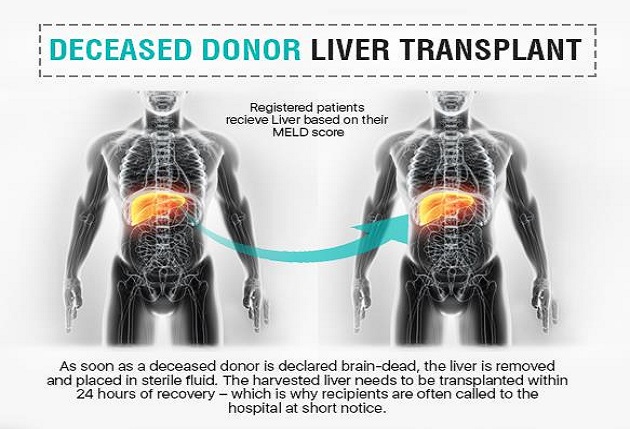Deceased Donor (Cadaveric) Liver Transplant
In deceased donor liver transplant, the donor is a brain-dead person, may be a victim of an accident, brain hemorrhage or head injury. The donor's heart is still beating, but the brain has permanently and irreversibly stopped functioning. Such a person is considered legally dead. At this point, the donor is usually in an intensive-care unit(ICU). The liver is donated, with the consent of the next of kin, from such individuals. whole livers come from such patients and can be used for an adult or a part of it can be used for a child. the only requisite is that the donor and recipient need to be of approximately the same size, and of compatible blood types. No other matching is necessary.
Process for Deceased donor Liver Transplant
Once recipient evaluation is completed, and the patient is found medically fit for transplant, the prescribed forms have to be completed and submitted through the hospital to the state-wide/ Zonal appropriate authority to register the patient’s name on the compatible blood group waiting list.
Patients may register at more than one hospital, even in different states.
After listing, patients should undergo periodic testing and review with the transplant team, and inform them of any significant changes in the patient’s medical condition. When a potential deceased donor liver is available, patients are alerted immediately and called to the hospital for surgery.
How long does it take to get a new liver?
If you become an active liver transplant candidate, your name will be placed on a waiting list. Patients are listed according to blood type, body size, and medical condition (how ill they are). Each patient is given a priority score based on three simple blood tests (creatinine, bilirubin, and INR). The score is known as the MELD (model of end stage liver disease) score in adults and PELD (pediatric end stage liver disease) in children.
Patients with the highest scores are transplanted first. As they become more ill, their scores will increase and therefore their priority for transplant increases, allowing for the sickest patients to be transplanted first. It is impossible to predict how long it will take for a liver to become available. Your transplant coordinator will always be available to discuss where you are placed on the waiting list. While you wait for a new liver, it would be best if you and your doctor discuss what you can do to stay strong for the impending surgery. You can also begin learning about taking care of a new liver.

